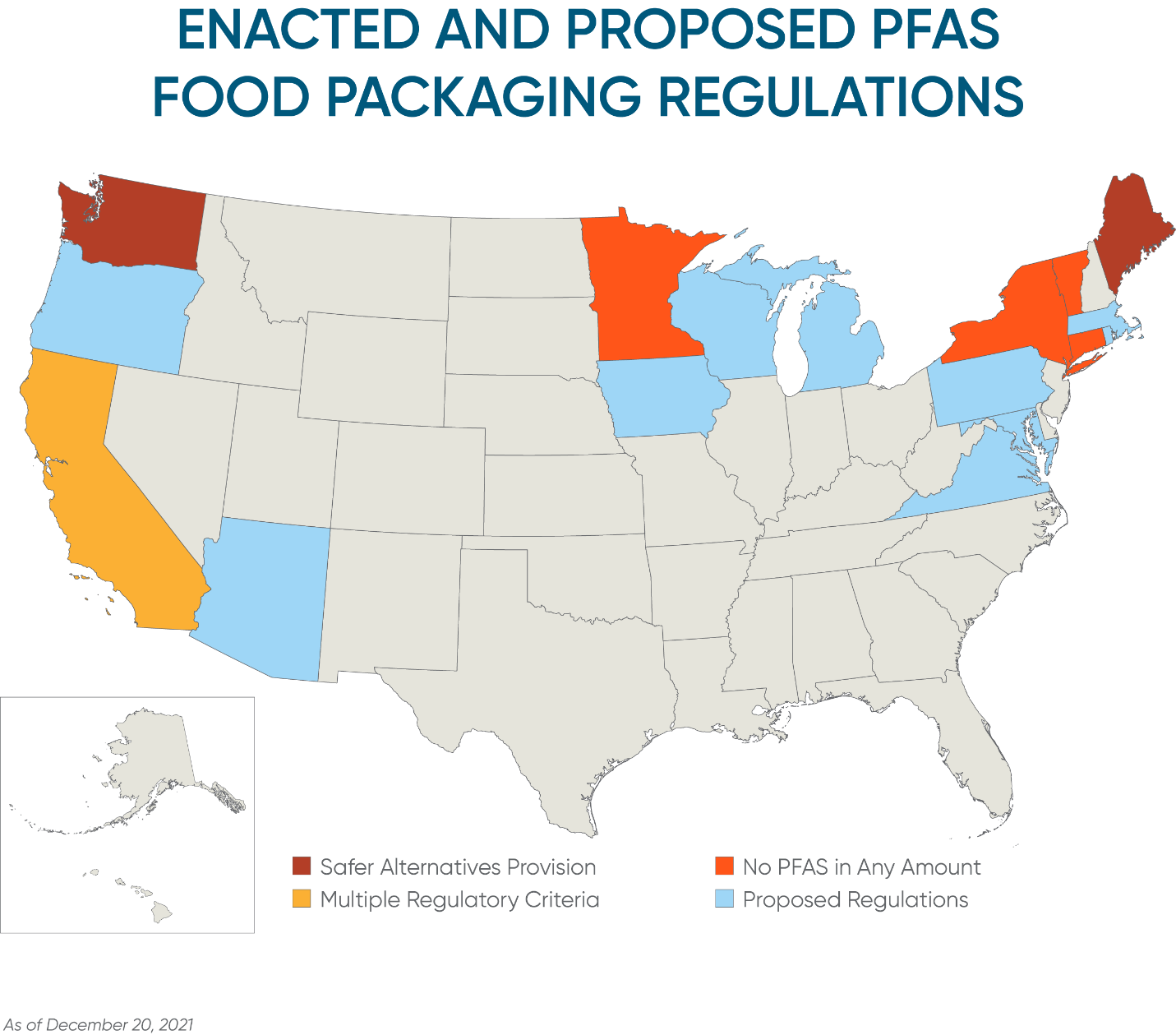BCLPemerging.com
PFAS Update: State Regulation of PFAS in Food Packaging
Dec 20, 2021This blog was originally published in December 2021. Visit our up-to-date blog on PFAS in food packaging: state-by-state regulations >
Seventeen states have either enacted or proposed limitations regarding using PFAS substances in food packaging containers and materials (“Food Packaging”). These regulations are intended to address public and agency concerns that the storage of food in Food Packaging that includes PFAS compounds may result in ingestion of those PFAS compounds. Commonly cited examples of Food Packaging that have historically contained PFAS compounds include certain pizza boxes, microwave popcorn bags, fast food containers, and candy wrappers.
The information below provides an overview of the federal and state regulatory landscape for PFAS in Food Packaging to help impacted businesses evaluate their compliance obligations and potential risk.
Federal Actions
Although federal action on this issue has been limited to date, the Food and Drug Administration (“FDA”) has taken some steps to limit PFAS use in Food Packaging, and more action is anticipated as part of the Biden administration’s PFAS plan.
The only federal prohibition on the use of PFAS compounds in Food Packaging is the Food and Drug Administration’s (“FDA”) elimination of two long-chain perfluorinated compounds from use in food packaging in 2016. The compounds were previously approved for use until the FDA removed that approval, not based on environmental or human health concerns, but based on the sole U.S. manufacturer of those compounds notifying FDA that it had abandoned the production of these two compounds so their continued approval for use was no longer needed. On July 31, 2020, the FDA announced a voluntary phase-out of certain type of short-chain PFAS compound in Food Packaging, but has not taken any further steps to ban or rescind approvals for the use of any other PFAS compounds
As part of the Biden-Harris Administration’s Plan to Combat PFAS Pollution, during the next three years, “FDA will proactively engage with and continue to support states when suspected areas of PFAS contamination may impact food and expand its PFAS analysis method development.” For example, the FDA has already studied 167 nationally distributed processed foods for PFAS substances. Although most foods sampled have shown no or low PFAS concentrations, in at least one instance the FDA required a dairy farm to dispose of milk based on PFAS concentration levels. Additionally, the FDA issued a letter to manufacturers and distributors of a certain type of Food Packaging “as a reminder that only certain fluorinated polyethylene containers are authorized for food contact use."
Outside of the agency context, on November 18, 2021, the Keep Food Containers Safe from PFAS Act of 2021 bill was proposed in the both the House of Representatives and the Senate. The bill states that “[t]he introduction into interstate commerce of food packaging containing intentionally added PFAS” should be prohibited in cookware or containers beginning on January 1, 2024. The bill was introduced in both houses of Congress last month, so it is unclear at this stage when, if at all, this bill will become enforceable.
State Food Packaging Regulations
In the absence of a blanket federal prohibition regarding the presence of PFAS compounds in Food Packaging products, several states have started to enact and propose regulations of their own.
A map showing the states that have enacted or proposed regulations regarding Food Packaging is below, along with a detailed chart discussing the specific provisions of those regulations. Because the regulation of Food Packaging is developing, it is important to note that this client alert reflects the status of state regulations in Food Packaging as of December 20, 2021.

|
State |
Food Packaging Description |
Regulatory Status |
Details |
|
Arizona |
Beginning on January 1, 2024, a person may not manufacture, sell, or distribute a food package to which PFAS substances have been intentionally added in any amount.
|
Proposed |
|
|
California |
Beginning on January 1, 2023, no person shall distribute or sell any food packaging that contains either: 1) PFAS that are intentionally added to a product and that have a functional or technical effect in the product; or 2) more than 100 ppm of PFAS substances as measured in total organic fluorine. Additionally, there are labelling and reporting requirements for certain manufacturers of cookware products.
|
Enacted |
|
|
Connecticut |
After December 31, 2023, no food package to which PFAS substances are intentionally introduced in any amount during manufacturing or distribution shall be offered for sale or for promotional purposes by its manufacturer or distributor.
|
Enacted |
|
|
Iowa |
Prohibits the manufacture, sale, and distribution of food packaging where PFAS substances are intentionally added in any amount, subject to an exception. Specifically, it does not apply to food packaging that was either imported or otherwise acquired prior to January 1, 2022. The Iowa Department of Public Health (“DPH”) will conduct a one-year study investigating PFAS substances in food packaging and will attempt to identify safer alternative food packaging materials. DPH must submit a report presenting its findings by December 31, 2022.
|
Proposed |
|
|
Maine |
The Maine Department of Environmental Protection (“DEP”) is permitted by statute to enact rules that prohibit a manufacturer, supplier, or distributor from offering for sale or for promotional purposes a food package to which PFAS substances have been intentionally introduced in any amount greater than an incidental presence. “Incidental presence” is defined by the statute as “the presence of a regulated metal or other regulated chemical as an unintended or undesired ingredient of a package or packaging component.” The DEP must determine that safer alternatives to the use of PFAS substances are available. If applicable, any prohibition for a product containing PFAS substances may not take effect until January 1, 2022, or two years following the date when DEP determines that a safer alternative is available, whichever is later.
|
Enacted |
|
|
Maryland |
After January 1, 2022, a manufacturer or distributor may not manufacture, distribute, or sell a food package to which PFAS substances have been intentionally added.
|
Proposed |
|
|
Massachusetts |
No person or entity shall manufacture, sell, or distribute food packaging to which PFAS substances have been intentionally added in any amount.
|
Proposed |
|
|
Michigan |
Beginning on January 1, 2023, a person shall not manufacture, sell, or distribute food packaging to which PFAS substances have been intentionally added in any amount greater than an incidental presence. "Incidental presence" is defined in the proposed bill as “the presence of a chemical as an unintended or undesired ingredient.”
|
Proposed |
|
|
Minnesota |
Beginning on January 1, 2024, no person shall manufacture, sell, distribute, or offer for use a food package that contains intentionally added PFAS. “Intentionally added" is defined by the law as “PFAS deliberately added during the manufacture of a product where the continued presence of PFAS is desired in the final package or packaging component to perform a specific function.” |
Enacted |
|
|
New York |
Beginning on December 31, 2022, no person shall distribute or sell food packaging containing PFAS substances as intentionally added chemicals. “Intentionally added chemical” is defined by a separate statute as a “chemical in a product that serves an intended function in the product component.” |
Enacted |
|
|
Oregon |
A person may not sell or distribute food service ware containing PFAS substances. Food service ware includes: (1) containers, such as bowls or plates; and (2) accessories including cups, lids, or utensils.
|
Proposed |
|
|
Pennsylvania |
Beginning on July 1, 2022, no person shall distribute, sell, or offer for sale food packaging containing PFAS substances in any amount.
|
Proposed |
|
|
Rhode Island |
Beginning on January 1, 2022, no person may manufacture, sell, or distribute food packaging to which PFAS substances have been intentionally added in any amount.
|
Proposed |
|
|
Vermont |
Beginning on July 1, 2023, a manufacturer, supplier, or distributor shall not manufacture, sell, or distribute a food package to which PFAS substances have been intentionally added and are present in any amount.
|
Enacted |
|
|
Virginia |
No person shall sell or distribute any food packaging that contains PFAS chemicals in any amount or to which PFAS chemicals have been intentionally added.
|
Proposed |
|
|
Washington |
Beginning on February 1, 2023, no person may manufacture, sell, or distribute food packaging to which PFAS chemicals have been intentionally added in any amount. This prohibition may not take effect until the Department of Ecology identifies that safer alternatives are available. The Department of Ecology published its findings in a report, dated February 2021, specifically stating that: (1) six chemical alternatives were less hazardous than PFAS; (2) one chemical alternative was more hazardous than PFAS; and (3) the data was insufficient to evaluate three chemical alternatives
|
Enacted |
|
|
Wisconsin |
Beginning January 1, 2025, no entity may distribute or sell any food packaging that contains intentionally added PFAS.
|
Proposed |
SB 361 |
Compliance Steps and Risk Mitigation for Businesses
The following are some initial steps that you can take to evaluate and mitigate your potential regulatory risk based on your manufacturing, distribution, or sale of Food Packaging that contains PFAS compounds:
- Evaluation. The obvious first step is to determine if your business manufactures, distributes, or sells any Food Packaging products which contain PFAS materials. There are a few fundamental questions that can guide your investigation:
- If you manufacture Food Packaging, do you intentionally add or introduce PFAS substances in any amount?
- Answering this question may require discussions with raw materials vendors, and an examination of your manufacturing process, including potential PFAS contamination of process water if any is used as part of your operations.
- Does your business sell, distribute, or offer for sale or use materials to which PFAS substances have been intentionally added?
- Once again, the answer to this question will likely rely on discussions with your suppliers and vendors.
- Companies should also review their purchase agreements and contracts with suppliers and customers to understand who is liable in the event that there is a sale of non-compliant products.
- Note that in California an additional question is whether your Food Packaging contains more than 100 ppm of total organic fluorine.
- If you manufacture Food Packaging, do you intentionally add or introduce PFAS substances in any amount?
- Alternates Analysis. Not surprisingly, there is a new industry trend towards PFAS free Food Packaging materials.
- If your business determines that any of your Food Packaging products contain PFAS, you should consider whether there are viable alternatives available.
- In addition to the state-funded studies discussed above, there are resources available which discuss alternatives to PFAS materials in food packaging, such as the publications by The Organization for Economic Cooperation and Development and the Clean Production Action.
Conclusion
As of the date of this publication, seven states have enacted various types of bans for Food Packaging. Moreover, ten additional states have proposed legislation in Food Packaging, and the federal government has indicated that it will take further action in this area over the next three years, suggesting that this is an area of importance, and probable regulatory expansion, in the near future.
If you have a question about how to manage PFAS risk in Food Packaging, please contact Tom Lee, John Kindschuh, Elyse Voyen, or any other member of our PFAS team at Bryan Cave Leighton Paisner LLP.
Related Capabilities
-
Environment
-
PFAS
-
Food & Agribusiness




